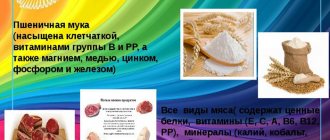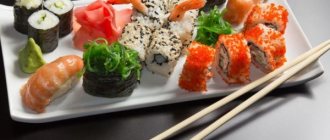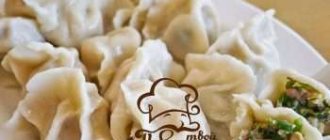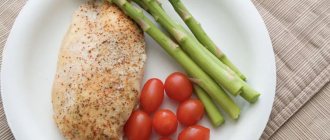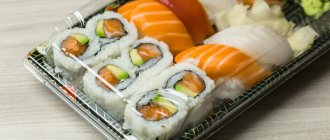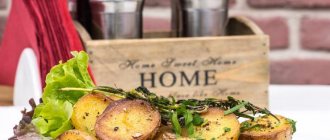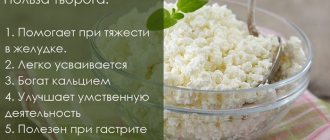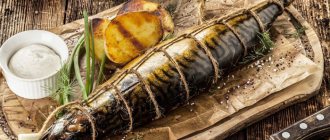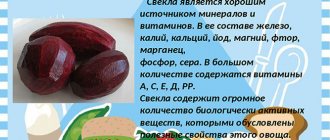A visit to a Japanese restaurant is a holiday for connoisseurs of healthy eating. A varied low-calorie cuisine with amazing flavor combinations is a real gift for all dieters who dream of a healthy and enjoyable dish at the same time. However, it is precisely in the huge number of recipes and cooking methods that the catch lies: the calorie content varies greatly. Let's figure out how many calories are in a serving of Philadelphia rolls and whether this combination of products is healthy.
- History of the dish
- Calorie content of rolls
- Composition of proteins, fats, carbohydrates
- Beneficial features
Chemical composition of Philadelphia rolls
The chemical composition of Philadelphia rolls depends on the components used.
The table shows an analysis of rolls with the following ingredients:
- nori;
- Philadelphia cheese;
- rice for rolls;
- lightly salted salmon;
- avocado.
| Average daily value, mg | Amount per 100 g serving, mg | |
| Vitamins | ||
| A | 900 mcg | 14.3 mcg |
| IN 1 | 1.2 | 0.07 |
| AT 2 | 1.3 | 0.152 |
| AT 3 | 16 | 0.45 |
| AT 4 | 500 | 20.98 |
| AT 5 | 5 | 0.98 |
| AT 6 | 1.3 | 0.29 |
| AT 9 | 400 mcg | 32.4 mcg |
| AT 12 | 3 mcg | 1.07 mcg |
| WITH | 90 | 2.38 |
| D | 10 mcg | 2.78 mcg |
| E | 14.6 | 1.08 |
| TO | 120 mcg | 4.02 mcg |
| PP | 20 | 2.72 |
| Minerals | ||
| Ca | 1000 | 109.87 |
| Fe | 10 | 0.91 |
| Mg | 400 | 29 |
| Ph | 700 | 220 |
| K | 2500 | 229.49 |
| Na | 1300 | 1004 |
| Zn | 11 | 0.89 |
| Cu | 1000 mcg | 138 mcg |
| Mn | 2.3 | 0.111 |
| Se | 55 mcg | 12.9 mcg |
| Cl | 2300 | 1220 |
| I | 150 mcg | 13.63 mcg |
| Co | 10 mcg | 5.45 mcg |
| F | 4000 mcg | 117.27 mcg |
| Cr | 50 mcg | 15 mcg |
Use of the product in diet
Like any food, sushi and rolls require a certain amount of consumption. It’s not for nothing that they are served with wooden chopsticks. This method of absorption of food should occur slowly and in small portions.
How to eat them correctly according to the recommendations of gastroenterologists:
- 1 serving should contain from 3 to 5 types, 2 pieces of each type.
- During a fasting day, it is best to consume several types.
- People on a diet are better off eating sushi and rolls together with other Japanese dishes. These are sashimi and seafood salads.
- During the “Sushi diet” it is better to drink more green tea without sugar and water.
The amount of food during a diet is different for everyone. The main requirement is benefits in reasonable quantities. It is not recommended to go on long-term diets of Japanese dishes. A weekly procedure will be sufficient. You should not eat sushi and rolls on an empty stomach.
Excessive amounts of substances can damage the walls of the stomach. The best time to consume it is dinner. Adding fish to the body saturates it with useful substances, and algae carries protein, vitamins and iron. Rice can satisfy hunger without adding excess weight.
The above recommendations will help to avoid poisoning and infection with harmful bacteria in the body. When in doubt, it is better to prepare sushi and rolls yourself. In this case, you can heat treat the fish. Such food will become a real exclusive on any table and will not make you doubt its quality.
The benefits and harms of the dish
Positive and negative properties are formed based on the composition of the dish.
| Ingredient | Beneficial features | Harm and possible contraindications |
| Nori |
| Excessive consumption of nori in food can lead to an excess of iodine. |
| White rice (glutinous) |
| Failure to comply with the norm can lead to:
|
| Lightly salted salmon | The high content of Omega-3 and -6 fatty acids (4.1 g and 0.9 g per 100 g) has the following positive effects:
Collagen in the composition increases the elasticity of the skin. |
|
| Philadelphia cheese |
|
|
| Avocado | As a result of the research, the following beneficial properties of avocado were identified:
| Due to its high calorie content, the product should be used with caution by overweight people. |
| Cucumber |
| Abuse of the product can lead to digestive system disorders and edema. |
Including Philadelphia rolls in the menu in moderation and subject to certain preparation rules can be beneficial to the body. People with diseases of the gallbladder, gastrointestinal tract, or stomach ulcers (especially during exacerbations) should avoid eating rolls. Overeating can cause constipation or allergies to certain ingredients.
Useful properties of the dish
Nutritionists have proven that eating sushi and rolls can really help you lose weight. These are low calorie foods. They give you the opportunity to satisfy your hunger and not gain excess weight. A fasting day can be arranged with these products. To be sure of the quality and composition, it is better to cook it yourself.
Sushi and rolls contain the following beneficial substances:
- Minerals are natural formations consisting of several elements. Affects the health of bones and teeth, the nervous system, blood pressure, cartilage and tissue. These are: calcium, phosphorus, magnesium, potassium, sodium.
- Vitamins are organic compounds necessary for normal development. Sushi and rolls can give a person vitamins B, C and D.
- Amino acids - a large number of them are part of proteins, which can be found in large quantities in fish meat. Very good for vision and bones.
- Microelements - the body constantly needs them. Responsible for the bone marrow and central nervous system. These include: iron, manganese, copper, zinc, selenium.
The main ingredient of rice is a complex carbohydrate. Contains fiber, gives the body energy and improves digestion. Fish and seafood are sources of iodine and protein. The algae used in making rolls is rich in iodine, a mineral for bones.
Calorie analysis
The table shows a list of the products most commonly used for making rolls and their calorie content.
| Ingredient | Calorie content 100 g, kcal |
| White rice for rolls (dry) | 370 |
| Lightly salted salmon | 202 |
| Philadelphia cheese | 342 |
| Smoked eel | 326 |
| Nori | 35 |
| Avocado | 160 |
| Cucumber | 14 |
| Tamago (egg omelette) | 154 |
| Sesame | 565 |
| Soy sauce | 60 |
| Wasabi | 292 |
| Pickled ginger | 20 |
| Rice vinegar | 54 |
| Tabasco sauce with hot peppers | 12 |
| Unagi sauce | 250 |
Main types of rolls
Calorie content directly depends on the components that are included in their composition:
- The main component is boiled rice, the calorie content of which is about 100 kcal per 100 g of finished product (however, remember that one roll contains less than 100 g of rice).
- The rolls also contain fish, meat or vegetables, which add additional calories.
- Also includes nori seaweed. Although these algae are quite high in calories (about 300 kcal per 100 g of product), there are only a few of them, so they do not make the rolls too high in calories.
Let's now calculate the calorie content of the rolls that Russians most often buy:
- "California". These rolls contain rice, seaweed and crab meat or crab sticks (Surimi). Optionally, hot wasabi sauce, avocado, cucumbers and some other ingredients can be added. A standard portion of California consists of 5-8 rolls, the total weight of which is about 200-300 g.
- "Philadelphia". These rolls contain rice, seaweed, salmon, and soft Philadelphia cheese, which is why they got their name. Avocado, caviar, cucumbers and some other components can also be added. A standard portion of Philadelphia rolls consists of 6 or 8 sushi rolls.
- There are also other types of rolls, which include eel, tuna, cucumbers, shrimp, and so on. Their calorie content will depend on the type and amount of filling.
What determines the calorie content of Philadelphia rolls?
Calorie content depends on the cooking method. For example, the most high-calorie foods are baked rolls and tempura. The latter are deep-fried in batter with a lot of oil. A 100 g serving of such rolls can contain about 200 kcal, baked – 270 kcal.
A dish with brown rice would be healthier. Despite the fact that the calorie content of the products is identical, brown rice contains more fiber (3.5 g, white - 2.8 g) and protein (7.6 g, white - 6.8 g).
The main component of rolls, white polished rice, can be the main reason for weight gain.
Brown rice undergoes minimal processing, as a result of which the beneficial substances are preserved in almost complete volume. In the process of grinding white rice, the husk, a source of valuable substances, is removed. The calorie content of a serving will increase if you add sauce to it. One of the most high-calorie sauces is Unagi, which is high in sugar.
100 g of Philadelphia cream cheese will add up to 342 kcal to the dish. To reduce the energy value of rolls, you can replace this cheese with less calories, for example, Creme Bonjour (270 kcal) or curd Almette (216 kcal). It is important to consider that the fat content in 100 g of these cheeses reaches 44-45%.
The most dietary option would be to use low-fat soft cottage cheese (37 kcal), to which greens are added to improve taste. Including fresh vegetables and herbs in the rolls will help reduce calories and increase the amount of fiber. Rolls with vegetables and herbs without adding rice will bring more benefits.
Sushi diet
The low calorie content of sushi and its extremely healthy composition make it an excellent option for a diet. The benefits of eating sushi for weight loss, in addition to the low calorie content of sushi, are as follows:
- this dish is convenient - it will not get cold, since it is already cold, it will not crumble (unless, of course, you wave your bag over your head), it does not require special dishes, like for soup, a sushi dish does not take up much space, it is convenient to eat - it does not crumble, does not drip, does not flow, etc.;
- you eat sushi with chopsticks, which is why the process of absorbing food becomes slower and more thoughtful, and we all know that food is better absorbed and satiation comes faster if you eat slowly;
- After a portion of sushi, you will not feel hungry for a very long time - despite its low calorie content, sushi satisfies very well and for a long time, because it contains complex carbohydrates and proteins.
Sushi is extremely healthy - it regulates metabolism, strengthens blood vessels and the heart, improves brain function, has a positive effect on muscle function, and has a beneficial effect on metabolism. The benefits, convenience and low calorie content of sushi and rolls have led many lovers of Japanese cuisine and followers of a healthy lifestyle to go on the so-called sushi diet.
The essence of the sushi diet is simple - you should eat only this dish, eating 3-4 servings of 6 pieces of sushi during the day, without repeating (that is, the more varied your sushi menu is, the better). As a result, you saturate your body with useful and nutritious substances, and the calorie content of your daily diet on a sushi diet will be no more than 1300 kcal, and when choosing low-calorie sushi - about 1000 kcal. The duration of the sushi diet is 1 week, weight loss is up to 4-5 kg.
However, the sushi diet has been criticized by nutritionists, despite the fact that they have a fairly favorable view of sushi as a product. Despite all the benefits and low calorie content of sushi, doctors do not recommend making your diet from them alone - no matter how varied the rolls and sushi are, they will not cover all the body’s needs for nutrients. The body needs other foods, not just rice and fish.
As a compromise between the classic sushi diet and the recommendations of nutritionists, we can offer you the following sample menu for a sushi diet:
- breakfast: 3 egg omelet with 2 small tomatoes and fresh herbs without fat, a glass of green tea with honey, whole grain bread;
- second breakfast: a glass of low-fat kefir or 100 g of natural yogurt (up to 3.5%);
- lunch: a portion of sushi (6 pieces), natural freshly squeezed juice or fruit drink, fruit jelly;
- afternoon snack: 5-6 prunes;
dinner: 100 g low-fat cottage cheese, 50 g green peas, apple or boiled chicken with green peas.
Calorie content of sushi 19 4.7
If you liked this article, please vote for it:
Leave a comment:
Energy value
Philadelphia rolls, whose calorie content can reach 176 kcal, have an average serving weight of 250 g. Thus, the weight of 1 piece, depending on the cutting method, is 32 or 42 g.
1 roll
The table shows the calorie content of 1 piece. rolls weighing about 42 g.
| 1 PC. (42 g) | Classic, kcal | Dietary option, kcal |
| Rolls according to Dukan | 42 | |
| With avocado and tuna | 57.2 | 43 |
| With cucumber and salmon | 69 | 46 |
| With crab and sesame | 67.5 | 52 |
| Baked rolls with vegetables and eel | 110 | 102 |
Serves 6-8 rolls
Below is an analysis of the calorie content of a serving of 6-8 rolls, with a total weight of 250 g.
Philadelphia rolls, the calorie content of which depends on the ingredients in the composition, can have a beneficial effect on the body or cause harm.
| 6-8 pcs. (250 g) | Classic, kcal | Dietary option, kcal |
| Rolls according to Dukan | 250 | |
| With avocado and tuna | 343 | 258 |
| With cucumber and salmon | 414 | 276 |
| With crab and sesame | 405 | 312 |
| Baked rolls with vegetables and eel | 660 | 612 |
Per 100 g
The table shows the caloric content of 100 g serving of rolls.
| 100 g | Classic, kcal | Dietary option, kcal |
| Rolls according to Dukan | 100 | |
| With avocado and tuna | 136 | 102 |
| With cucumber and salmon | 164 | 109 |
| With crab and sesame | 160 | 123 |
| Shrimp roll | 383 | 140 |
| Baked rolls with vegetables and eel | 262 | 243 |
Rolls and diet
The calorie content of the rolls is very low. The weight of 1 roll is from 25 to 45 g, the weight of an average serving of 6 rolls is about 180-230 g. Thus, 1 serving of rolls contains on average about 350 calories - quite enough to satisfy hunger, get the necessary energy and nutrients and don't overeat
Please note that the calories in rolls are contained either in complex carbohydrates (rice, vegetables), or in easily digestible proteins and healthy fatty acids (seafood). There are no “empty” or harmful calories in rolls
They really are an example of a properly balanced dietary dish, prepared taking into account a person’s daily need for a certain amount of proteins, fats and carbohydrates, as well as in accordance with the principles of separate nutrition. When preparing rolls, products undergo minimal temperature treatment, which protects the beneficial substances they contain. And the tradition of eating rolls with chopsticks, slowly, without rushing, is another plus, because while you eat, chewing each piece of food thoroughly, your brain gradually receives a signal of satiety, and this happens in a timely manner, and not when you have already overeaten. And when you eat in a hurry (the standard “coffee and cookies” option when there is no time for lunch), you manage to eat one and a half times more than you need before the necessary enzymes in the stomach are released in sufficient quantities to notify the brain that that eating can be stopped.
The calorie content of rolls is the reason why they are an excellent option for both a dense carbohydrate-protein breakfast and a hearty but dietary lunch. But you still shouldn’t eat rolls for dinner, despite the low calorie content of rolls. For dinner, it is better to eat something lighter and less carbohydrate, for example, a couple of apples, a piece of boiled fish, a vegetable salad or cottage cheese.
Popular articles Read more articles
Walking and calories 12/02/2013
We all walk a lot during the day. Even if we have a sedentary lifestyle, we still walk - after all, we...
611469 65 More details
How to lose weight at 50 10/10/2013
Fifty years for the fair sex is a kind of milestone, crossing which every second...
453509 117 More details
Running and calories 12/02/2013
Nowadays, running no longer evokes a lot of enthusiastic reviews, as it did thirty years ago. Then society would...
357613 41 More details
Hypoallergenic diet 09/11/2013
A hypoallergenic diet is used for all types of allergies, regardless of their origin, as it allows…
303810 2 More details
Balanced diet 11/19/2013
A balanced diet is one that fully and in the correct proportion ensures the intake of...
247276 8 More details
Calorie content of pies 11/26/2013
We all love pies. For many, pies are memories of childhood, of Saturday mornings, of the village; grandma's pi...
245902 13 More details
Is it possible to eat sushi while losing weight?
When losing weight, you can eat rolls, taking into account the recommendations for reducing the calorie content of the dish:
- you need to avoid eating baked rolls and tempura; in terms of calorie content and harmful properties, they are similar to fast food;
- you should completely abandon rice, or periodically add brown rice to the dish instead of white;
- the amount of brown rice consumed should also be limited;
- rice retains water and produces a strengthening effect;
- salty, sweet and sour sauces slow down the process of removing fluid from the body and increase appetite;
- when choosing soy sauce, you should choose a naturally fermented sauce without the use of wheat;
- Reduced sodium soy sauce contains 25% less salt;
- pickled ginger is prepared with the addition of large amounts of sugar and vinegar, which completely destroys its benefits for weight loss;
- such a product can lead to irritation of the walls of the esophagus;
- mayonnaise (including Japanese) should be avoided;
- Rolls should be washed down with green tea without added sugar;
- green tea is a source of antioxidants;
- it is able to quench thirst after eating salty foods.
What is sushi
The popularity of Japanese cuisine in our country and around the world has been constantly growing in recent decades, and the greatest demand is not for traditional Japanese seaweed soups, salads, meat or fish dishes, but for unique Japanese fast food - sushi and rolls.
The main ingredients of these cold appetizers are white cooked unsalted rice and raw, lightly salted or smoked fish. Seafood, caviar, vegetables (for example, cucumber, zucchini), fruits (avocado, pineapple, etc.), nuts, cream cheese, Japanese omelette, etc. can be used as additional ingredients. Rolls and sushi must be consumed with soy sauce. Pickled ginger and wasabi are served as piquant seasonings.
The calorie content of sushi in its classic form - rice and fish - is extremely low, but its useful and nutritional value is extremely high. Rice is a source of B vitamins, vitamins K and PP, fiber, magnesium, calcium, potassium, manganese, iron, copper and zinc. Fish contains vitamins A, E and D, calcium, fluorine, phosphorus, zinc, potassium and iodine. In addition, fish contains essential fatty acids omega-3 and omega-6, which are very beneficial for the human body, which prolong youth and life.
Sushi and rolls are very healthy dietary dishes, provided, of course, that their recipes suit the taste preferences of our country. Often, instead of the most delicate cream cheese, sushi manufacturers generously flavor them with mayonnaise - it’s cheaper, more satisfying, and more familiar to our citizens. Only these rolls and sushi contain much more calories than those prepared according to the original recipe, so when ordering sushi and rolls, be interested in their composition. When counting the calorie content of sushi and rolls, do not forget about soy sauce, wasabi and ginger - these products also contain a certain amount of calories.
